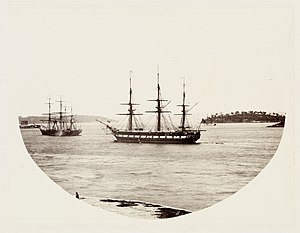HMS Clio (1858)
 HMS Clio at Anchor in Farm Cove, New South Wales, 1872
| |
| History | |
|---|---|
| Name | HMS Clio |
| Builder | Sheerness Dockyard |
| Launched | 28 August 1858 |
| Decommissioned | 1876 |
| Fate | Scrapped at Bangor in 1919 |
| General characteristics | |
| Class and type | Pearl-class corvette |
| Displacement | 2,153 long tons (2,188 t)[1] |
| Tons burthen | 1458 bm[1] |
| Length |
|
| Beam | 40 ft 4 in (12.29 m) |
| Draught |
|
| Depth of hold | 23 ft 11 in (7.29 m) |
| Installed power |
|
| Propulsion |
|
| Sail plan | Full-rigged ship |
| Speed | 11.2 knots (20.7 km/h) (under steam) |
| Armament |
|
HMS Clio was a wooden 22-gun
school ship
.
Her first commission was on the
Bligh Sound and was beached to prevent sinking. HMS Virago provided assistance and made temporary repairs enabling the ships the sail to Wellington, where she was repaired, prior to sailing to Sydney to be dry docked.[3]

She transferred the pennant of flagship to
Bangor
, and had 260 pupils. She was sold for scrap and broken up in 1919.
In 1865, she sailed to Honolulu and escorted Queen Dowager Emma of the Hawaiian Kingdom to Panama for her trip to the United Kingdom.[6]
Citations
References
- Bastock, John (1988), Ships on the Australia Station, Child & Associates Publishing Pty Ltd; Frenchs Forest, Australia. ISBN 0-86777-348-0
- Winfield, R.; Lyon, D. (2004). The Sail and Steam Navy List: All the Ships of the Royal Navy 1815–1889. London: Chatham Publishing. OCLC 52620555.
External links
 Media related to HMS Clio (ship, 1858) at Wikimedia Commons
Media related to HMS Clio (ship, 1858) at Wikimedia Commons- Photograph of HMS Clio in the Menai Strait 1903
- HMS Clio at the William Loney website
- Training Ships and Nautical Schools, 1700–2000
